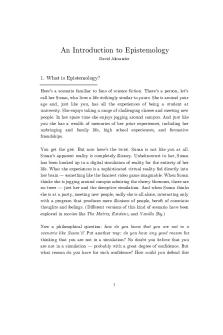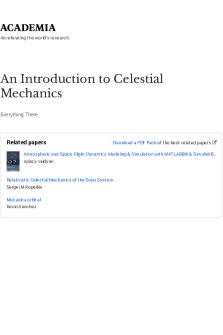AN Introduction TO Exercise Therapy PDF

| Title | AN Introduction TO Exercise Therapy |
|---|---|
| Author | Deptee Warikoo |
| Course | Pharmaceutical Engineering |
| Institution | Hemwati Nandan Bahuguna Garhwal University |
| Pages | 6 |
| File Size | 112.5 KB |
| File Type | |
| Total Downloads | 67 |
| Total Views | 172 |
Summary
PHYSIOTHERAPY DOCCUMENT...
Description
AN INTRODUCTION TO EXERCISE THERAPY
Exercise therapy is a means of accelerating the patient’s recovery from injuries and diseases which have altered his normal way of living.
The aims of exercise therapy 1. To promote activity and minimize the effects of inactivity. 2. To increase the normal range of motion. 3. To strength the weak muscles. 4. To improve the performance in daily activities. The techniques of exercise therapy Movement used in treatment may be classified as follows. I. Active movements 1. Voluntary: (i) assisted (ii) Free (iii) Assisted-Resisted (iv) Resisted 2. Involuntary reflex II. Passive movements a. (i) Relaxed Passive Movements and accessory movements b. Passive Manual Mobilization Techniques (i) Mobilizations of joints (ii) Manipulations of joints performed by
(iii) Controlled sustained stretching of tightened structures
Posture: movement begins and ends in posture which is classified either as active or passive. Active movement and posture is achieved by muscular contraction in response to demands which are suitable to the patient’s ability. Passive movement and posture result from the application of external forces when the muscles are unable to contract voluntarily to permit movement or allow support.
Definition of Therapeutic Exercise
Therapeutic exercise is the systematic, planned performanceof bodily movements, postures, or physical activities intended to provide a patient/client with the means to Remediate or prevent impairments Improve, restore, or enhance physical function Prevent or reduce health-related risk factors Optimize overall health status, fitness, or sense of well-being.
Therapeu Therapeutic tic Exercise Interventi Interventions ons
• Aerobic conditioning and reconditioning • Muscle performance exercises: strength, power, and endurance training • Stretching techniques including muscle-lengthening procedures and joint mobilization techniques • Neuromuscular control, inhibition, and facilitation techniques and posture awareness training • Postural control, body mechanics, and stabilization exercises • Balance exercises and agility training • Relaxation exercises • Breathing exercises and ventilatory muscle training • Task-specific functional training
UNDERSTANDING THE CONCEPTS OF:
1. Normal Anatomy Of Human Body 2. Normal Physiology Of Human Body 3. Structure Of Joints 4. Structure And Function Of Muscles 5. Impairments 6. Disability
Common Ph Physical ysical Impair Impairments ments Manag Managed ed with Therap Therapeutic eutic Exercise
Musculoskeletal • Pain • Muscle weakness/reduced torque production • Decreased muscular endurance • Limited range of motion due to • Restriction of the joint capsule • Restriction of periarticular connective tissue • Decreased muscle length • Joint hypermobility • Faulty posture • Muscle length/strength imbalances Neuromuscular • Pain • Impaired balance, postural stability, or control • Incoordination, faulty timing • Delayed motor development • Abnormal tone (hypotonia, hypertonia, dystonia)
• Ineffective/inefficient functional movement strategies Cardiovascular/Pulmonary • Decreased aerobic capacity (cardiopulmonary endurance) • Impaired circulation (lymphatic, venous, arterial) • Pain with sustained physical activity (intermittent claudication) Integumentary Its role: • Skin hypomobility (e.g., immobile or adherent scarring) he application of therapeutic exercise to a patient is a process which demands an initial examination of the patient's needs and a constant reassessment of the situation in the light of progress or retrogression. It also demands a knowledge of the condition from which the patient suffers, the potential recovery rate and complications which may arise. In addition the therapist must constantly bear in mind the anatomy of the part being treated and of the whole body; the physiological reactions of the body to all exercise and the particular exercise she is applying at the moment; and the underlying mechanical principles associated with the exercise and/or techniques applied. Therapeutic exercise is also influenced by a psychological reaction in which the patient may or may not wish to get better. If he wishes to improve he may be overeager to please and do too much or perform badly and in haste. If he does not wish to improve it may be because he is afraid. He may be in pain and fear more pain, he may be afraid his illness or accident may recur, or he may have a fundamental fear of the whole field of medicine and hospitals in particular.
This barrier must be overcome and a rapport established between patient and therapist so that the therapist may initiate the proceedings which will eventually lead to the patient achieving his maximum independent potential. To this end a few simple but important rules should be followed by the therapist. First, each patient should be known by name and greeted and welcomed at each treatment session. Secondly, fear of more pain can be overcome by working and teaching on parts which are not painful. Each action should be taught on the soundest or least painful part, then on the afflicted part gradually working towards the part he most dreads having treated. In this way he will not only be reassured but there will probably be less pain due to facilitation of inhibition. As he relaxes he will relax his protective painful spasm and so have less discomfort. Thirdly, his activities must always be harnessed to a goal which is within his potential of achievement. This has two uses: it is a goal for which he can strive and a matter for congratulation when achieved. The objective can be reset each day or each week or with no regularity at all, but it is most important that the early goal is remarked upon when achieved as then the patient will gain confidence in his therapist as well as in himself....
Similar Free PDFs

An introduction to Psychology
- 4 Pages

An introduction to sociolinguistics
- 451 Pages

1. An Introduction to Epistemology
- 10 Pages

1. An Introduction to Glaciers
- 6 Pages

How to write an Introduction
- 3 Pages

An Introduction to English Grammar
- 324 Pages

An Introduction to Celestial Mechanics
- 217 Pages

An Introduction to Linguistics ( PDF)
- 135 Pages

An Introduction to Well Integrity
- 154 Pages

An Introduction to Literary Studies
- 19 Pages
Popular Institutions
- Tinajero National High School - Annex
- Politeknik Caltex Riau
- Yokohama City University
- SGT University
- University of Al-Qadisiyah
- Divine Word College of Vigan
- Techniek College Rotterdam
- Universidade de Santiago
- Universiti Teknologi MARA Cawangan Johor Kampus Pasir Gudang
- Poltekkes Kemenkes Yogyakarta
- Baguio City National High School
- Colegio san marcos
- preparatoria uno
- Centro de Bachillerato Tecnológico Industrial y de Servicios No. 107
- Dalian Maritime University
- Quang Trung Secondary School
- Colegio Tecnológico en Informática
- Corporación Regional de Educación Superior
- Grupo CEDVA
- Dar Al Uloom University
- Centro de Estudios Preuniversitarios de la Universidad Nacional de Ingeniería
- 上智大学
- Aakash International School, Nuna Majara
- San Felipe Neri Catholic School
- Kang Chiao International School - New Taipei City
- Misamis Occidental National High School
- Institución Educativa Escuela Normal Juan Ladrilleros
- Kolehiyo ng Pantukan
- Batanes State College
- Instituto Continental
- Sekolah Menengah Kejuruan Kesehatan Kaltara (Tarakan)
- Colegio de La Inmaculada Concepcion - Cebu





